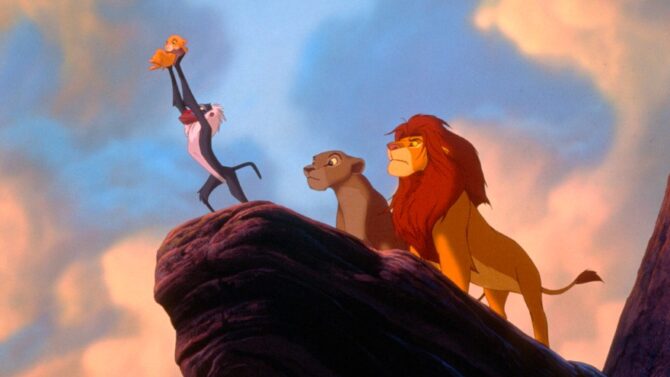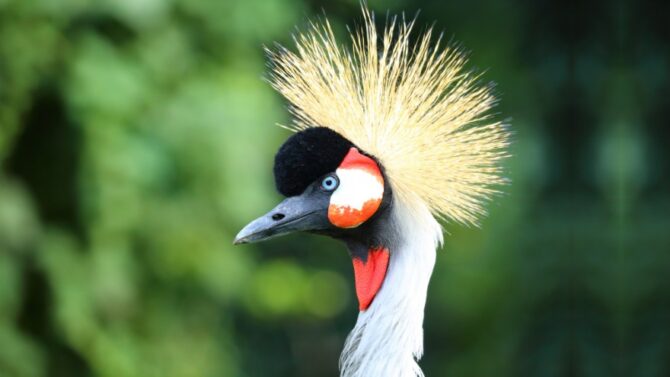Madagascar is a unique island country located off the southeast coast of Africa.
It is home to an incredibly diverse wildlife species, most of which can be found in other parts of the world.
Amongst the massive biodiversity are some of the most dangerous animals in Madagascar.
From venomous reptiles and blood-sucking insects to aggressive mammals, the wildlife in Madagascar can be deadly.
So, in this article, we’ll explore the top 10 deadliest animals in Madagascar, and provide insights on how to stay safe while exploring the natural beauty of the island.
What are the Most Dangerous Animals in Madagascar?
1. Nile Crocodile

- Scientific name: Crocodylus niloticus
- Habitat: Mangrove swamp, freshwater marshes, Nile basin
- Threats: Aggressive predators, can attack humans when threatened or defending their territory
The Nile crocodile is a dangerous apex predator that can be found in many African countries, including Egypt and Madagascar.
It often stays close to freshwater bodies, and would hardly be found around salt water.
These reptiles have a bite force of over 5,000 pounds, which can spell disaster for a victim.
You must avoid any area where these crocodiles might be, and if you sight one make sure it doesn’t see you.
As an apex predator, the Nile crocodile isn’t afraid of humans and will attack without provocation. If you get bitten, go for medical treatments.
2. Black Widow Spider

- Scientific name: Lactrodectus menavodi
- Habitat: Crevices, woodpiles
- Threats: Highly venomous spider, bites can cause muscle pain, cramps, and spasms
Black widow spiders can be found in all continents around the world except Antarctica.
The variant in Madagascar is known as the Malagasy black widow spider, and it shares a common trait with all other black widow spiders—It is venomous.
The only fortunate side of the black widow spider is that it isn’t aggressive.
Unlike the Nile crocodile, the black widow spider is not inclined to attack humans without provocation.
It strikes as a defense mechanism when it feels threatened.
3. Scorpions
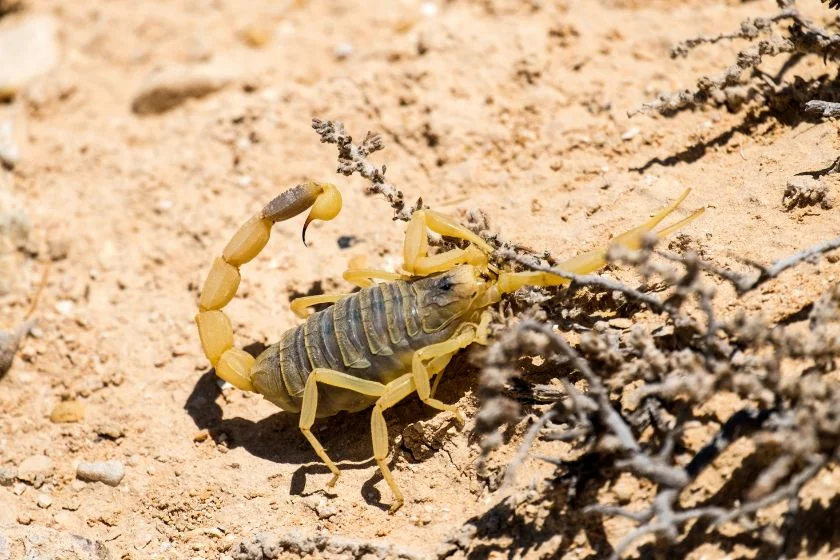
- Scientific name: Scorpiones
- Habitat: Tropical rainforests, grasslands, desert
- Threats: Venomous, painful sting, potentially deadly to humans with allergies or weak immune system
Like the black widow spider, scorpions can be found on every continent except Antarctica, and there are over 60 species in Madagascar alone.
These arachnids are dangerous and should be avoided at all costs.
A sting from the scorpion is enough to paralyze an adult human, in addition to it being painful.
It can also lead to swelling of the organs, and often require medical attention.
Scorpions are more active in the morning and evening, so you should protect yourself when hiking, and even when you want to sit in an area.
4. Madagascar Hissing Cockroaches

- Scientific name: Gromphadorhina portentosa
- Habitat: Rotten logs, riverbanks, leaf litters
- Threats: Can trigger allergies and asthma in some people
If you think the cockroach in your environment is creepy, you haven’t met the hissing cockroach.
The Madagascar hissing cockroach doesn’t pose the same danger as the first three animals mentioned on this list.
But it comes with a host of bacteria and germs that would cause disease, turning your vacation into a nightmare.
The hissing cockroach can be found only in Madagascar, and it is one of the biggest cockroach species in the world today.
It is so named because of its hissing sound and can be kept as exotic pets. The wild ones are the main dangers.
5. Pelican Spider

- Scientific name: Archaeidae sp.
- Habitat: Arid environments like desert, caves, leaf litter, under rocks, stones, or bark
- Threats: The venom of some species can cause severe pains and skin necrosis in humans
The pelican spider is also called the assassin spider, and the name alone shows how deadly it can be.
The venom can cause paralysis, and in some cases even lead to death.
Because it isn’t too widespread, some people don’t think it doesn’t exist, but it does, and it should be avoided.
In Madagascar, there are a lot of them, and it is easy to locate a pelican spider even in a lodge.
Be sure the environment around you is free of these spiders, alongside other bugs that can stay close to humans.
6. Chameleon

- Scientific name: Chameleonidae
- Habitat: Savannah, rainforest, deserts, steppes
- Threats: Some species have sharp teeth and can deliver painful bites if provoked
The chameleon is an easily recognized reptile, and its ability to camouflage by changing colors has made it a popular animal to explore.
Some have been exported from Madagascar and other African countries and are kept as pets.
Wild chameleons, however, are a different story.
Chameleons are generally solitary animals, and they would feel threatened if a human comes too close.
They are not venomous like snakes, but their bite can be painful. In their defense, they hiss warning before attacking.
There’s no evidence of it killing a human, but you should still stay away.
7. Malagasy Fruit Bat

- Scientific name: Pteropodidae
- Habitat: Forest, savannas
- Threats: Can carry diseases that can be transmitted to humans, including the deadly Marburg virus
Fruit bats are also called megabats, the old world fruit bats, and the flying foxes.
There are over 100 fruit bat species in existence today, and they can be found in continents like Australia, Asia, and Africa.
They are somewhat rare in Madagascar but live there nonetheless.
Fruit bats seem harmless as they appear to just flutter around not minding humans.
They also don’t have venom or poison. However, they bear a host of viruses that can cause disease, and they can transmit that by scratching you.
These diseases are serious and would require urgent medical attention.
8. Indris
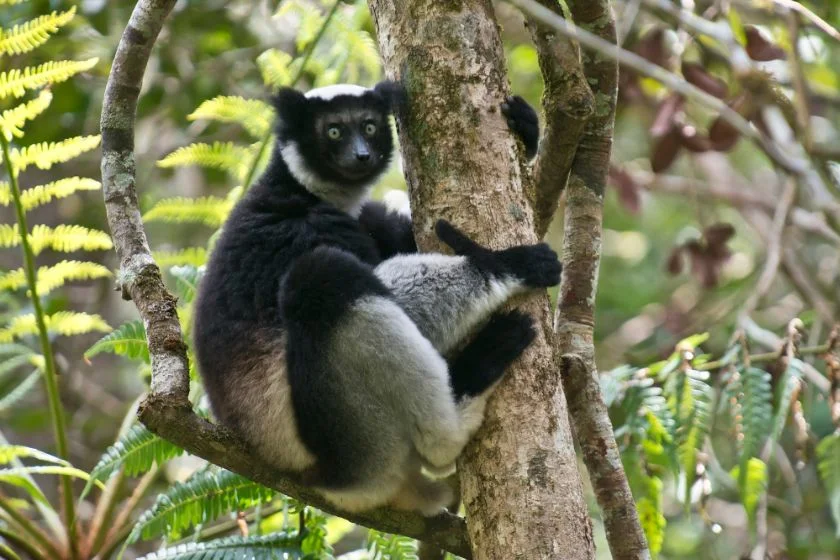
- Scientific name: Indri indri
- Habitat: Lowland
- Threats: Can attack if threatened
The indri is called the babakoto, and it is considered one of the biggest lemurs in existence today.
Their posture is upright like humans, and it often lives on trees.
The black-and-white color of the indri makes it a pleasant sight, but there are some problems with this animal.
The indri isn’t friendly towards humans and is known to be aggressive when provoked.
Its screech alone is enough to give you goosebumps, and the attack can leave you with injuries.
9. Fossa
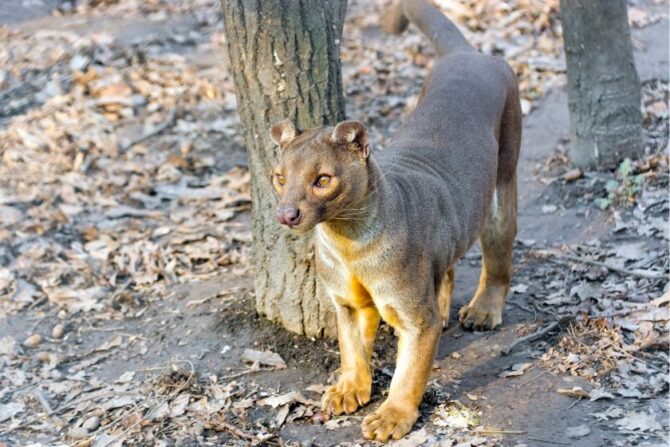
- Scientific name: Cryptoprocta ferox
- Habitat: Forest
- Threats: Top predators in their ecosystem, can attack humans if they feel threatened
The fossa is a rare animal that can be found only in Madagascar. It looks similar to a cougar and is usually compared with one.
It also has catlike features but isn’t part of the Felidae family.
The fossa is the largest predator in the country and is active both during the day and night; so the chances of seeing one are high.
Their size can be compared to that of a medium-sized dog, so being at the end of its attack is like being attacked by a wild dog.
The fossa isn’t known to hesitate when it sees a human and will attack if it considers you a threat.
You should stay away from any encounter with this animal.
10. Sea Snakes

- Scientific name: Hydrophinae
- Habitat: Tropical waters
- Threats: Many species have venom that is dangerous to humans, bites can be fatal without quick medical attention.
The sea snake can be found in different places, from Madagascar to the Asian continent.
Some of the deadliest sea snake species include the yellow-bellied sea snake, black-banded sea snake, and many more.
As the name implies, it often stays close to waterbodies, so you should be watchful when exploring those areas.
The sea snake is highly venomous, and the venom has adverse effects.
It may not kill if you get fast treatment, but it can still lead to organ failure, paralysis, swelling, and breathing difficulties.
Madagascar Wildlife Safety Tips
Madagascar is safer compared to other tourist sites, especially when it comes to wildlife.
However, you can’t afford to be reckless, even if the animal you see isn’t one of the dangerous animals listed above.
Here are some tips that can act as a guide when exploring the Madagascar wildlife:
- Figure out where the aggressive animals reside and avoid those areas. Avoiding these animals is better than trying to escape. If possible, hire a guide who knows the terrain.
- Be sure your lodging is free of the smaller, dangerous animals like black widow spiders and scorpions. Also, wear solid boots and clothes that cover your skin when stepping out.
- Do not go too close to any animal, but maintain enough distance that you won’t be able to touch the animal if you stretch your hands forward.
Related Questions
Are there lions and tigers in Madagascar?
Madagascar is home to many animals, but lions and tigers are not one of them. Unlike what we see in movies, there are no tigers in Madagascar. The same applies to giraffes, hippos, and zebras.
What poisonous snakes are in Madagascar?
Madagascar has more than 80 snake species living on the island, and besides the sea snake, none of these snakes are considered harmful.
Highly dangerous snakes like mambas, pythons, and vipers are not in Madagascar.
Are there any predators in Madagascar?
The largest predator in Madagascar is the fossa (Cryptoprocta ferox). Their size can be compared to that of a terrier and they are cat-like relatives of the mongoose, with long tails that measures up to their body length.
Conclusion
“Safety first!” is a good rule of thumb for any endeavor you wish to undertake, including taking a trip to an island.
Understanding the potential risks posed by some of the most dangerous animals in Madagascar is crucial for staying safe while exploring.
You’ll get the best experience if you’re able to avoid any harm, especially from animals that aren’t human-friendly.
Up Next
- Top 20 Most Dangerous Animals In The World, With Statistics
- 10 Most Venomous Snakes In The World (Poisonous & Dangerous)

